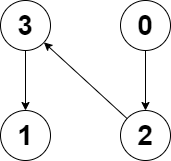LeetCode in Kotlin
2360. Longest Cycle in a Graph
Hard
You are given a directed graph of n nodes numbered from 0 to n - 1, where each node has at most one outgoing edge.
The graph is represented with a given 0-indexed array edges of size n, indicating that there is a directed edge from node i to node edges[i]. If there is no outgoing edge from node i, then edges[i] == -1.
Return the length of the longest cycle in the graph. If no cycle exists, return -1.
A cycle is a path that starts and ends at the same node.
Example 1:

Input: edges = [3,3,4,2,3]
Output: 3
Explanation: The longest cycle in the graph is the cycle: 2 -> 4 -> 3 -> 2.
The length of this cycle is 3, so 3 is returned.
Example 2:

Input: edges = [2,-1,3,1]
Output: -1
Explanation: There are no cycles in this graph.
Constraints:
n == edges.length2 <= n <= 105-1 <= edges[i] < nedges[i] != i
Solution
class Solution {
fun longestCycle(edges: IntArray): Int {
val n = edges.size
val vis = BooleanArray(n)
val dfsvis = BooleanArray(n)
val path = IntArray(n)
var maxLength = -1
for (i in 0 until n) {
if (!vis[i]) {
path[i] = 1
maxLength = Math.max(maxLength, dfs(i, 1, path, vis, dfsvis, edges))
}
}
return maxLength
}
private fun dfs(
node: Int,
pathLength: Int,
path: IntArray,
vis: BooleanArray,
dfsvis: BooleanArray,
edges: IntArray,
): Int {
vis[node] = true
dfsvis[node] = true
var length = -1
if (edges[node] != -1 && !vis[edges[node]]) {
path[edges[node]] = pathLength + 1
length = dfs(edges[node], pathLength + 1, path, vis, dfsvis, edges)
} else if (edges[node] != -1 && dfsvis[edges[node]]) {
length = pathLength - path[edges[node]] + 1
}
dfsvis[node] = false
return length
}
}

